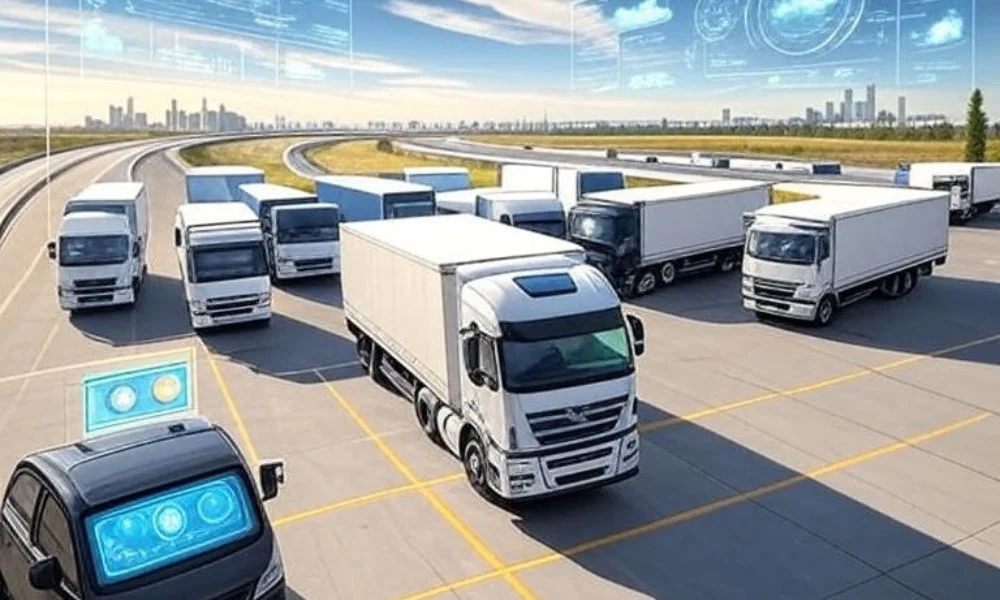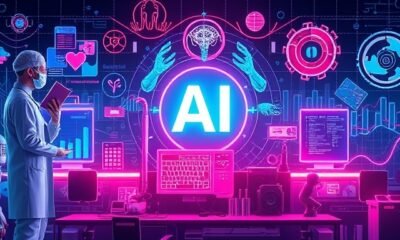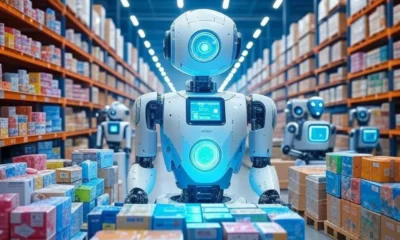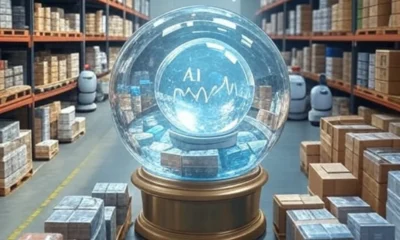Artificial Intelligence
Machine Learning Models for Delivery ETAs
Accurate delivery ETAs are now powered by machine learning, offering faster and smarter arrival time predictions for packages and food orders. This article explores real-world examples, model types, and future trends in AI-driven delivery systems across the United States.

Back to my side of the door, I am a customer, and I need to have solid ETA of delivery so that I can plan my day; I can know that an establishment feels the heat to deliver on this expectation. That is why the delivery ETAs are now being implemented through machine learning models by companies all over the United States so that they can accurately solve this tricky issue.
These AI-enabled systems are used to analyze previous data and actual time data to make very precise forecasts. This translates to less unexpected, more satisfied customers and improved delivery service. It is either a logistics company or a food delivery app but nowadays businesses are coming up with new features to impress users with their deliverables.
Definition:
Delivery ETAs are models of machine learning which relies on historic data to provide real-time accurate estimations.
I can assure you that this article will lead you through the working process of these smart models, the functions it is based on, and the most effective ones. I will also talk about real-life examples of huge brands in the U.S. so that you can feel the effect of AI. At the end of this session, you will get to know everything about how and why machine learning is a boon in enhancing the ETAs and improving on the accuracy that is needed in the contemporary delivery services.
What Are Delivery ETAs and Why Do They Matter?
By delivery ETAs I refer to the estimation of the time when a package or an order is estimated to arrive at its destination. ETA is used in logistics and delivery, the delivery is the approximate time of arrival, here it is crucial in communicating with a customer. I would want that time to be steady whether it is monitoring food order or an Amazon package.
Where companies give wrong ETAs, these create confusion and frustration. In this situation as a customer, I will lose the trust when I expect the delivery of 2 PM, but I receive it at 4 PM. That disjunction of promise and performance spawns negative reviews, canceled orders, and wastage of resources. ETA predictions that are inaccurate also cause businesses another problem in route planning, resource allocation, and efficiency.
You are possibly familiar with the mechanism of Amazon, Uber Eats, and DoorDash determining the real-time ETAs, which are dependant upon your position and on traffic. These numbers do not stand still and are continuously updated with machine learning. The fact that that visualization is real time really matters to me as a user since I would feel informed and valued through the process.
Traditional ETA Estimation vs. ML-Based ETA Estimation:
Prior to machine learning, the majority of the firms used stagnant and rule-based applications to calculate delivery times. These systems had some predetermined factors such as average speeds, travel times that were not changeable and routes that were changeable. Another instance is that a delivery route between one city to another may always be estimated to require two hours no matter the conditions.
Such approaches were unable to respond to real-world issues such as road congestions, weather conditions, or any sudden interruptions. Should a truck get stuck behind an accident, this would escape the notice of the system and ETA would not change. This caused confusion to the customers and support teams. Such a strategy caused the operations issues and seldom satisfied the customers in the modern “fast-forwarded” world.
Machine Learning Approach:
The machine learning models are not founded on ascertain routes or assumptions. They study tons of historical data on previous delivery to capture trend and patterns over time. I have observed how they use past delays, the time that it took to deliver and how the road is to make an estimate of the time it may take to deliver the new delivery.
What makes these models even more powerful is their ability to improve with time. The more data they receive, the more accurate their predictions become. They also adapt well to different industries and regions. Whether it’s a short food delivery in a busy city or a freight delivery across rural highways, machine learning customizes ETA predictions for each case.
Key Features Used in ETA Prediction Models:
I consider what makes ETA predictions accurate, so I must admit that it depends on the data these models embrace. Numerous features are necessary to comprehend patterns in terms of delivery via machine learning models. These characteristics instruct the model on when delays most of the time occur as well as how to prevent them. The more the features are critical, the more the ETA prediction is applicable in the real life.
Historical delivery information is one of the most vital data points. This consists of the old delivery times, pick and drops records, and the journey time that was spent. I observed that this information can make models learn what triggers at particular routes. It also takes trends by the time of the day or the nature of whatever is being delivered.
GPS and route information are also essential since they display the beginning and the point of the delivery. These are some of the points that aid the model in determining travel routes and determining the right distance. Real time and past traffic conditions are also a part of the model which has a significant influence on forecasting delays. Static estimates can be disestablished by: rush hour traffic, road work or even a big event in a city.
Weather conditions such as rain or fog or snow can give a sudden slowdown to the deliveries. Weather APIs are used by machine learning to modify the prediction following the real-time conditions. Models applied by me also occasionally use time-of-day and day-of-week patterns. As an example, the delivery process in the mornings on Monday might be slower than that on Thursday in the afternoon because of congested roads or the driving style.
Other systems even measure the driver performance to customize the ETAs. The experienced skilled driver may not take too long as a new driver. Lastly, the nature of order (its size and weight, special handling information, etc.) may affect the speed of delivery. A large amount of a package or order of food may take a longer time of travel or service.
Here’s a quick breakdown of the most common features used:
-
Historical delivery data (timestamps, durations, past delays)
-
GPS and route details (pickup, drop-off, distance, road type)
-
Traffic data (live congestion, historical bottlenecks, incident reports)
-
Weather conditions (rain, snow, temperature, visibility)
-
Time-based factors (hour of day, day of week, season)
-
Driver behavior (average speed, past routes, delay history)
-
Order details (size, type, quantity, temperature needs)
By combining all these elements, machine learning models can deliver accurate, location-aware ETAs that respond to changing real-world conditions.
Model Training Pipeline for Delivery ETAs:
To be able to give delivery ETAs predictions, a machine learning model must be trained according to a systematic pipeline. I have witnessed the effectiveness and efficiency of this step wise approach in areas where businesses develop acceptable and workable systems that are functional to the real world. Each section of this pipeline – data collecting, model deployment, etc. is essential.
It begins with data acquisition that will imply receiving input of GPS tracking systems, weather services, and traffic APIs. Such sources give raw data needed during training. As an example, GPS data will provide traffic routes and timestamps, and there are traffic APIS which will provide the congestion level on highways and urban roads.
Upon collection of data the next step is data preprocessing. In this case, the dirty data are cleaned, transformed and rendered usable in the model. Some of the projects that I have contributed to involved dropping the outliers, interpolating gaps, and converting the delivery logs into a time series. It is also at this time when feature engineering occurs which enables the model to pick up the correct pattern.
Training of the model starts. In this step, the machine learning algorithm is provided the ready data and trains on it. To determine the most effective configuration of parameters and ensure that the model will work well with new deliveries, I apply such methods as the hyperparameter tuning and the cross-validation. In its absence, the forecasts would be inconsistent and unlikely to work.
When the model has been trained, its performance is then measured. The most popular ones are MAE (Mean Absolute Error) and RMSE (Root Mean Square Error). These are the ones showing delta between the expected arrival times and the real ones. Other system may also compute prediction intervals demonstrating how certain they are of their eta.
The next stage of the model is deployment. This is whereby real-time APIs are formed to allow the model to give predictions on-demand. These APIs are tracked on the basis of performance, uptime and accuracy. I would encourage using monitoring mechanisms all the time to see how the model will resonate in the real world.
Real-Time ETA Prediction Architecture:
On my opinion, real-time ETA systems should be able to address the variability of situations and user needs as their architecture must be modern and scalable. The majority of high-performance systems that are employed now rely on cloud infrastructure or microservices to ensure that everything is swift, stable, and segmented. Each service does a given operation such as the processing of data, the estimation of the ETA or the offering of an API response.
To be able to maintain real-time ETAs these systems tend to use streaming traffic and GPS data. Such ready-made platforms as Apache Kafka or MQTT are deployed to process the flow of data continuously coming to vehicles, traffic sensors, and mobile devices. The systems are useful in revising ETAs whenever a change occurs such as when traffic decreases.
Models can be used in two types here the batch models and the streaming models. Traditional batch models train on historical data and get updated after some time whereas streaming models respond to any new data in real-time. I have discovered that a combination of the two came up with a decent ratio of precision and response.
The other important segment of the architecture is route optimization integration. When the ETA has been computed, the system is able to get the most efficient or fastest route. The integration allows drivers not to fall behind and customers have a better experience. It also assists business to cut their delivery expenses and enhances the efficiency of time.
Challenges in ETA Prediction:
Even though as good as machine learning is there are pitfalls to creating an ETA prediction system. I have had experience with models that have done good in tests and did not work in production because of issues encountered in the real world. It is equally important to deal with those edge cases as it is to ensure model accuracy.
Among those are data sparsity or the loss of GPS signals. In some cases, gadgets go off the line, or completely cease to transmit data. In that case, the model must interpolate the gaps by estimation methods and this decreases reliability. This occurs more frequently in rural areas and it impacts on delivery estimates.
The other major problem is how to handle the varying traffic conditions or delivery conditions. A normally clear road might have some construction work that would block it. Such dynamic changes are difficult to foresee, particularly the situation with a system that does not update its data regularly.
I also experience problems with edge-case management like road delays, weather-related emergencies, or change of drivers on the way of delivery. These occurrences are not prevalent, yet they can cause some serious disruptions in ETA forecasts unless the system is designed to be flexible.
There are also complications with scaling across the city or types of delivery. What works in New York may not work in Los Angeles unless it is retrained. Company needs to meet the demands of both local preciseness and overall expandability.
Lastly, there is that of latency versus accuracy. Predictions that are quicker are required by a real-time system, yet a more precise model would require additional time to be computed. The right balance is important when it comes to providing speed and reliability.
Real-World Applications of Machine Learning for ETA Predictions:
I have been an Uber and Lyft user, and I always feel impressed when their ETA estimation is changing in real time. Such apps deploy the use of machine learning in calculating the arrival time of a driver when they need to be picked up or when to finish a trip. The system factors in real time traffic, road modifications, and driver patterns to provide me with some of the best projections regarding the state of traffic.
Models that they use are renewed all the time based on new traffic trends and seasonal fluctuations. As it happens, the system will make adjustments quicker than what a conventional tool would during a busy Friday night. Such an ongoing cycle of learning makes the predictions of the ETA new, similar, and reliable across various cities and conditions of drivers.
Amazon and FedEx:
The huge delivery companies such as Amazon and FedEx may be limited without the ETA models since they handle large delivery volumes per day. These systems forecast delivery time windows in terms of the type of the package, location of address and the warehouse availability. I have already observed how I get text updates of changes in ETAs even though the order is only a few minutes.
Machine learning is useful to these firms as they encounter high seasons such as holidays or black Friday. In times of intensity, the models change routes, redistribute tasks and issue predictions of delays before they occur. This translates into less missed-deliveries, improved planning and a more pleasant experience on the part of the delivery driver or me.
Food Delivery Apps:
DoorDash, Zomato and Foodpanda food delivery services are under the pressure of different issues that challenge the way these companies operate: very short delivery windows. These are apps that rely on AI models, which take a few seconds to adapt to changing circumstances such as the time it takes to prepare an order or waiting time in a restaurant. The expectations of a customer towards a 20-minute delivery would start at that mark.
Dynamic rerouting and reassignments of riders are supported by these systems too. In case one of the riders is late, the system is able to replace it with closer driver for delivery. This is because the ETA refreshes my screen in real time making me less agitated and frustrated. Without machine learning, this could not be a flexible process.
Future of ETA Prediction Using ML:
In the future, I think the ETA prediction will be even more personal, quick and privacy-protective. Federated learning, one of the advancing facets, enables models to be trained on device to prevent the sharing of personal user information. This method helps in enhancing performance and still ensuring that sensitive information remains safe.
There is another critical tendency, namely edge AI that enables making predictions either on the mobile devices or delivery vehicles. The result is less time to make a cloud request and better response in near real time. It works ideally where connectivity is poor or the demands are high.
Greater involvement of satellite imagery, and IoT sensors will also be noticed. The tools will assist in the detection of road conditions, monitoring the health of the delivery vehicles, and additional data on wiser decisions. I would like the AI models to embed uncertainty level to their prediction and inform the user how confident the system is about an ETA.
Such innovations will result in more responsive, transparent and scalable ETA systems. They will be crucial to such industries as healthcare, emergency logistics, smart cities.
Conclusion:
Prediction of delivery times by using machine learning models has transformed the whole process of companies predicting when they will deliver their products. They are able to base more up to date, precise, and customer-friendly ETA predictions depending on complicated real-time data. Be it a meal, a ride or a package, I now anticipate my ETA to reflect changes in conditions as they happen.
This technology can provide a significant benefit in case you work in part with a business based on deliveries. First, gather the correct data, simulate situations in the real world with your models, and implement forecasts using robust APIs. This will be worth the effort especially to the satisfaction of the customer as well as the efficiency of operations.
-

 Artificial Intelligence8 months ago
Artificial Intelligence8 months agoWhat is Artificial Intelligence? A Comprehensive Guide for Businesses and Enthusiasts
-

 Artificial Intelligence6 months ago
Artificial Intelligence6 months agoHow to Use Grok AI: A Complete Guide
-

 Artificial Intelligence8 months ago
Artificial Intelligence8 months agoUnlocking the Power of Artificial Intelligence Tools
-

 Artificial Intelligence7 months ago
Artificial Intelligence7 months agoWhat is DeepSeek? Revolutionizing AI with Cutting-Edge Solutions
-

 Artificial Intelligence3 months ago
Artificial Intelligence3 months agoAI Technologies in Warehouse Automation:
-

 Artificial Intelligence4 months ago
Artificial Intelligence4 months agoMeta’s AI Push: The Standalone Assistant App Set to Rival ChatGPT
-

 Artificial Intelligence3 months ago
Artificial Intelligence3 months agoHow Artificial Intelligence is Revolutionizing Logistics:
-

 Artificial Intelligence3 months ago
Artificial Intelligence3 months agoPredictive Analytics for Demand Forecasting:


